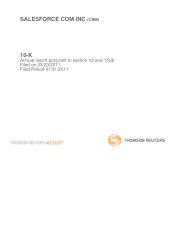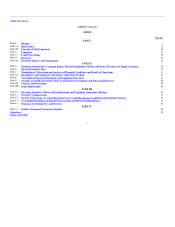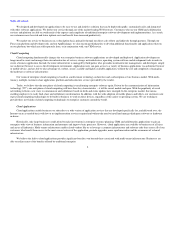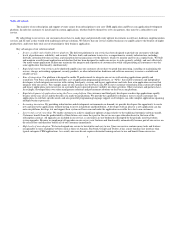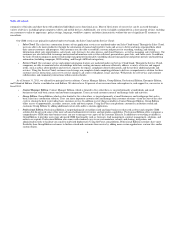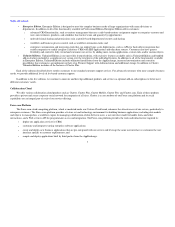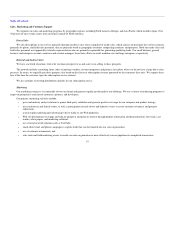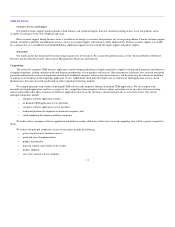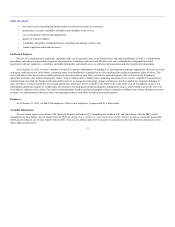Salesforce.com 2010 Annual Report Download - page 5
Download and view the complete annual report
Please find page 5 of the 2010 Salesforce.com annual report below. You can navigate through the pages in the report by either clicking on the pages listed below, or by using the keyword search tool below to find specific information within the annual report.
Table of Contents
We designed and developed our applications to be easy-to-use and intuitive solutions that can be deployed rapidly, customized easily and integrated
with other software applications. We deliver our service through any of the market-leading Web browsers. Customers who use our CRM and collaboration
services and platform are able to avoid much of the expense and complexity of traditional enterprise software development and implementations. As a result,
our customers incur less risk and lower upfront costs and benefit from increased productivity.
We market our service to businesses on a subscription basis, primarily through our direct sales efforts and indirectly through partners. Through our
Force.com platform and developer tools and our AppExchange, we also encourage third parties to develop additional functionality and applications that run
on our platform, but which are sold separately from, or in conjunction with, our CRM service.
Cloud Computing
Cloud computing fundamentally changes the way enterprise business software applications are developed and deployed. Application developers no
longer need to create and manage their own infrastructure of servers, storage, network devices, operating system software and development tools in order to
create a business application. Instead, the entire infrastructure is managed by third parties who specialize in infrastructure management, and developers simply
use an Internet browser to access the development environment. Application users can gain access to a variety of business applications via an Internet browser
or mobile device, and are able to take advantage of a robust, secure, scalable and highly available application, without the cost and complexity of managing
the hardware or software infrastructure.
Our vision of enterprise cloud computing is based on a multi-tenant technology architecture and a subscription service business model. With multi-
tenancy, multiple customers share application, platform and infrastructure services provided by the vendor.
Today, we believe that the next phase of cloud computing is transforming enterprise software again. Driven by the consumerization of information
technology ("IT"), our next phase of cloud computing will have three key characteristics – it will be social, mobile and open. With the popularity of social
networking websites, new ways to communicate and collaborate based on feeds and status updates have emerged. In the enterprise market, that means
enabling employees to easily find, share and collaborate on information. In addition, with the wide adoption of mobile phones and tablets, our customers now
expect cloud computing technologies to be built for business to work on these devices, regardless of the carrier or operating system. We are working to
provide these new kinds of cloud computing technologies to enterprise customers around the world.
Cloud Applications
Cloud applications enable businesses to subscribe to a wide variety of application services that are developed specifically for, and delivered over, the
Internet on an as-needed basis with few or no implementation services required and without the need to install and manage third-party software or hardware
in-house.
Historically, only large businesses could afford to make investments in enterprise resource planning, CRM and collaboration applications to gain an
enterprise-wide view of business information and automate and improve basic processes. However, cloud applications are available to businesses of all sizes
and across all industries. Multi-tenant architectures enables cloud vendors like us to leverage a common infrastructure and software code base across all of our
customers who benefit from access to the most current release of the application, periodic upgrades, more rapid innovation and the economies of a shared
infrastructure.
We believe the shift to cloud applications provides significant benefits even beyond those associated with multi-tenant infrastructure. Businesses are
able to realize many of the benefits offered by traditional enterprise
2

